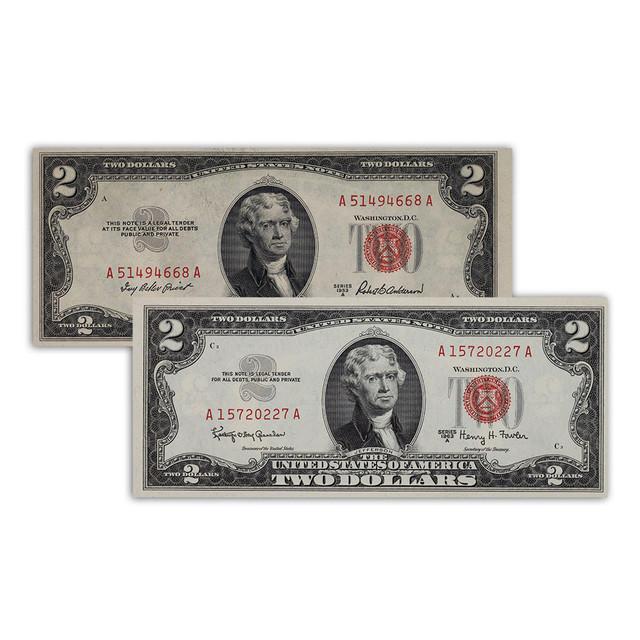$2 Bill Value: How Much Is a Two Dollar Bill Worth?
Posted by Andrew Adamo on May 19th 2025
$2 Bill Value: How Much Is a Two Dollar Bill Worth?
Many Americans have a $2 bill or two tucked away, often seen as a novelty. But what few realize is that some of these notes are worth far more than their face value. Whether you’re a seasoned numismatist or just getting started in currency collecting, understanding the value of $2 bills can unlock hidden treasures. Continue reading to learn more about $2 Bill Value.

Historical Context: More Than Just Pocket Change
Originally issued in 1862, the $2 bill has had a turbulent history. Early versions featured Alexander Hamilton, but by 1869, Thomas Jefferson became the face of the bill. Over time, the bill fell out of regular circulation, gaining an odd reputation and even a few myths. The 1976 redesign reintroduced it with a depiction of the signing of the Declaration of Independence.
Despite their relative rarity in circulation, $2 bills are still printed today. According to the Bureau of Engraving and Printing, as of 2022, over 1.2 billion $2 bills are in circulation—but most people hoard them instead of spending them.
$2 Bill Timeline at a Glance
| Era | Key Design & Seal | What Makes It Special | Typical Value Range* |
|---|---|---|---|
| 1862–1869 “Hamilton” Legal Tender | Large-size note, red seal | First U.S. $2 bills; Alexander Hamilton portrait | $250 – $5,000+ |
| 1874–1917 “Jefferson” Legal Tender | Large-size, red seal | Classic ornate reverses; Series 1890 & 1891 “Brown Backs” | $150 – $4,000+ |
| 1928–1963A Red-Seal Small Size | Jefferson obv., Monticello rev. | First modern-size deuces; star notes scarce | $10 – $650+ |
| 1976–Today Green-Seal | Signing of Declaration rev. | Bicentennial relaunch; still printed in small runs | Face – $25 (common), higher for errors/fancy serials |
| *Prices assume VF 20 – Gem CU 65. Exceptional serial numbers, errors, or grades above 66 can command multiples of these figures. | |||
What Makes a $2 Bill Valuable?
Not all $2 bills are created equal. A variety of factors contribute to their value:
1. Series Year and Seal Color
- Older Bills Are Often More Valuable: $2 bills from the 19th century, particularly those from 1862-69 featuring Alexander Hamilton on the obverse, can fetch hundreds to thousands of dollars depending on their condition.
- Red Seal vs. Green Seal: Red-seal notes (1928-1963) are generally more collectible than the green-seal notes as the red-seal was retired after 1963 while the green-seal is still in use today.
2. Serial Numbers
- Low Numbers & Patterns: Bills with serial numbers like 00000001 or patterns such as 12344321 (a radar note) are highly prized due to the rarity of such serial numbers.
- Star Notes: An asterisk next to the serial number indicates a bill is a replacement for a misprinted bill, reprinted to ensure the number of bills in each production batch is the same. These notes, often called star notes, are hard to find, especially in good condition, and can be worth much more than face value.
3. Printing Errors
- Misaligned seals, ink smears, and other anomalies can significantly boost a bill’s value. These errors are typically caught early and replaced with star notes, making survivors rare and collectible.
4. Condition (Grading)
- Bills are graded on a scale from Poor to Gem Uncirculated. A crisp, uncirculated bill will always be worth more than its worn counterpart.
According to data from Heritage Auctions and PCGS Currency, rare $2 bills in excellent condition can sell for:
- $500 to $1,200 for star notes from the 1928 series
- $2,000+ for low serial numbered notes from the 1890s
- Up to $4,000 for a 2003 $2 bill with a unique serial number
Where to Start: Help for New and Experienced Collectors
Whether you’re assessing your childhood keepsakes or building a professional portfolio, sourcing authentic, valuable notes can be challenging. That’s where Bullion Shark comes in. We specialize in helping both novice and seasoned collectors identify, verify, and purchase rare $2 bills.
Our experts provide grading assessments, historical research, and access to hard-to-find notes that can elevate any collection. With a focus on transparency and authenticity, Bullion Shark is a trusted name in U.S. currency collecting.
Every $2 bill has a story—and potentially, a hidden value. From rare serial numbers to historical significance, the right note could be worth far more than $2. With resources like Bullion Shark and a bit of knowledge, anyone can tap into the fascinating world of currency collecting.
FAQ
Are $2 bills still printed?
Yes. The Bureau of Engraving and Printing last produced them in 2024 (Series 2022), but quantities are tiny compared with $1s or $20s, which fuels the “rare” myth.
What is the most valuable $2 bill?
Examples include the 1890 “Brown Back” Treasury Note and the 1869 “Rainbow” Legal Tender in Gem CU, each topping $20,000 at auction.
How do I spot a fancy serial?
Look for eight-digit patterns: solids (88888888), radars (12344321), ladders (01234567), birthdates (19950704). Any of these on a pristine modern $2 can bring $100–$500.


